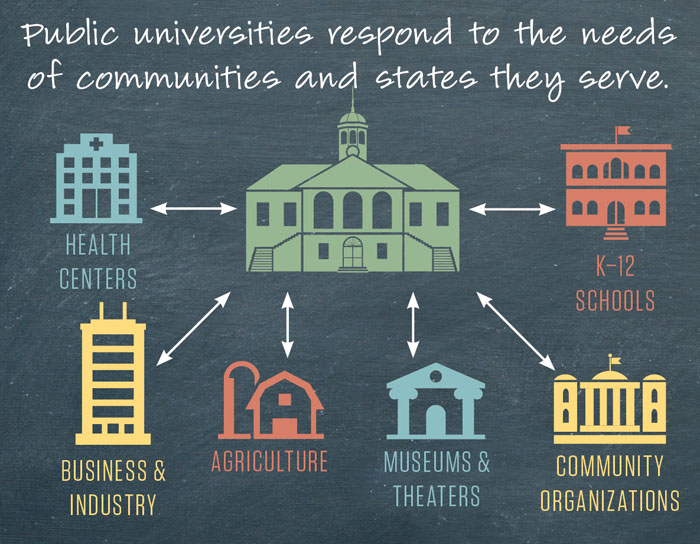How does public university research and community engagement benefit society at large?
Key Takeaways
- Public research universities conduct two-thirds of university-based research and a large share of federally funded research. This research improves our collective understanding of the world around us, helps cure debilitating diseases, and fosters innovations that grow our economy.
- Public research universities played a central role in developing: touch screens and lithium-ion batteries that are used in smartphones, laptops, and electric vehicles; a variety of antibiotics used to treat diseases like tuberculosis; and breakthroughs in crop genetics that sowed the seeds of the Green Revolution, helping save a billion people from starvation globally.

Public universities’ positive impact extends well beyond the confines of their campuses. Indeed, it is a core part of public universities’ mission to serve their communities and there is scarcely a corner of society that doesn’t benefit from their work. These institutions contribute to their local communities, regional and state economies, the country, and world through research, innovation, and community engagement.
Drivers of Discovery
In addition to educating highly skilled graduates who invest in and contribute to their communities, public universities play a key role in enhancing lives through their cutting-edge research in nearly every conceivable field and industry. Public universities annually conduct over $57 billion of research (66 percent of all university-based research), driving progress in our world through the discovery and dissemination of new knowledge.1
Around the world, people benefit from discoveries made at public universities in the United States. Research undertaken at public universities has led to countless groundbreaking innovations and technologies that have transformed life.
A small sampling of these include:
- Touch screens and lithium-ion batteries that are used in smartphones, laptops, and electric vehicles2
- A variety of antibiotics used to treat diseases like tuberculosis3
- Breakthroughs in crop genetics that sowed the seeds of the Green Revolution, helping to save a billion people from starvation4,5
- The CRISPR gene-editing system that promises to help combat a litany of debilitating diseases and viruses2
Centers of Civic & Economic Engagement

Public research universities have a responsibility to ensure the vibrancy and prosperity of their communities. These institutions undertake significant community engagement efforts that span every segment of society—from K–12 schools to hospitals and health centers, agricultural cooperatives to urban neighborhood organizations, environmental sustainability groups to lifelong learning institutes. Students, faculty, and staff partner with civic organizations, businesses, and government to address the most pressing challenges in their communities.
Public research university leaders strive to align their work with the strengths and needs of their communities, their region, and the nation. Public universities help create “innovation ecosystems,” engaging public and private partners to advance economic opportunity and vitality. Institutions also work with business and industry partners on curriculum development to ensure that educational opportunities meet workforce needs in addition to a host of other student learning outcomes.
A Wall Street Journal analysis found the presence of a university leads to lower overall unemployment, higher economic output, and even higher earnings for non-college educated workers in the area. The analysis also found counties with land-grant universities had substantially higher manufacturing productivity growth. Because research universities are major drivers of talent, innovation, and economic development, large companies often make proximity to a major university a requirement when considering where to expand.
Public universities are major engines of entrepreneurship and economic growth. Over a two year period, research at public research universities led to 3,278 patents, produced 522 start-up companies, and yielded 3,094 technology licenses. These activities lead to ventures, products, and services that advance and improve society.2

1. National Science Foundation, National Center for Science and Engineering Statistics, Higher Education Research and
Development Survey (2014).
2. American Academy of Arts & Sciences, “Public Research Universities: Serving the Public Good,” 2016.
3. Cole, Jonathan. “The Great American University,” 2009.
4. Kephart, Kevin, South Dakota State University, “About Edgar S. McFadden,”2016.
5. Rosenberg, Tina. “A Green Revolution, This Time for Africa,” The New York Times, 2012.




Stay Connected
X (formerly Twitter)
Facebook
YouTube
LinkedIn
RSS